Round The World and other travels
A frequent flyer's collection of trip diaries
This is: A Yorkshire Ramble (2014)
Magnificent York
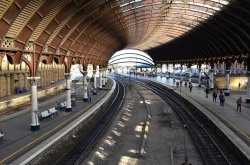 |
| ABOVE: York Station is built on a grand scale |
The Highland Chieftain gently slowed and slipped sedately under the majestic glass and iron roof arches of York's imposing railway station. Standing next to one of the doors of Coach M and seeing that the train had almost come to a stop, I prepared to execute the steps of a quaint British ritual once familiar to many citizens of this island, but now confined to longer-distance travellers on surviving examples of a certain type of diesel-powered rolling stock dating from the 1970s and referred to at that time as High Speed Trains. I lowered the door's sliding window - manually, obviously - reached out and awkwardly grasped for the external door handle, gently turned it to release the door catch, retrieved my arm to the relative safety of the carriage's interior and finally pushed the hinged door open so that I could step onto the platform. Being a reasonably public-spirited soul, I even paused to return the window to its closed position before leaving the scene. In the unlikely event that someone should ever corner you at a social function to regale you with tales of this country's state-of-the-art infrastructure, I invite you to remind the deluded braggart of what could still be involved in alighting from a train in AD2014.
 My
journey had begun over three hours earlier, in Central Scotland.
While still planning the trip, I had been successful in securing a
seat in one of the first-class coaches at a sensible,
advance-purchase price. With the journey underway, I had been
surprised to find a first-class load factor of around 85-90% - thank
heavens for reserved seats! As we proceeded southwards via Edinburgh
and Newcastle, I had been able to enjoy a range of refreshments and
a complimentary sandwich lunch, as well as a comfortable individual
seat. Two of the snack items had struck me as curiously appropriate
for an Anglo-Scottish journey to Yorkshire: Border-branded
biscuits and Harrogate mineral water. Shortly after leaving
Newcastle, the train had sped through the cathedral city of Durham,
prompting me to ponder all that was due to be accomplished before I
would see it again, towards the end of the trip. In due course, as
we have already seen, I arrived at
my first destination and easily found my way to my chosen base, the
Hampton by Hilton hotel, for the first of two separate stays in York. The weather was dull but unbelievably warm for
October.
My
journey had begun over three hours earlier, in Central Scotland.
While still planning the trip, I had been successful in securing a
seat in one of the first-class coaches at a sensible,
advance-purchase price. With the journey underway, I had been
surprised to find a first-class load factor of around 85-90% - thank
heavens for reserved seats! As we proceeded southwards via Edinburgh
and Newcastle, I had been able to enjoy a range of refreshments and
a complimentary sandwich lunch, as well as a comfortable individual
seat. Two of the snack items had struck me as curiously appropriate
for an Anglo-Scottish journey to Yorkshire: Border-branded
biscuits and Harrogate mineral water. Shortly after leaving
Newcastle, the train had sped through the cathedral city of Durham,
prompting me to ponder all that was due to be accomplished before I
would see it again, towards the end of the trip. In due course, as
we have already seen, I arrived at
my first destination and easily found my way to my chosen base, the
Hampton by Hilton hotel, for the first of two separate stays in York. The weather was dull but unbelievably warm for
October.
Ever since my first visit to York in the early 1980s, it has remained one of my favourite UK destinations. Founded in AD71 at the confluence of the Ouse and Foss rivers, it was called Eboracum by the Romans, a name that gradually evolved into Eoforwic. The Vikings amended this to Jorvik, which in turn became the name that we know today. York became an important ecclesiastical centre in the Middle Ages, a role that it retains to the present day: York Minster, seat of the Archbishop of York, is the city's greatest single attraction. York became a major railway centre in the nineteenth century, helped by its strategic position roughly halfway between London and Edinburgh, so it seemed entirely appropriate that I had arrived by train. The city used to be the home of Rowntree's confectionery, a once-popular UK brand that was eventually absorbed into the Nestlé empire. Nowadays, tourism is vitally important to the city's economy and a host of attractions, both historical and modern, vie for the visitor's attention.
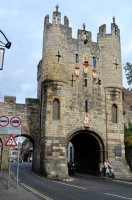 |
| ABOVE: Beer drinkers may be disappointed by Micklegate Bar |
With all of this background - together with happy memories of several previous visits - swirling around inside my head, and having spent most of the day so far sitting on a train, I was naturally keen to get started on seeing a destination that I had last visited in 2010. I began just a short walk away from my hotel, by calling in at Micklegate Bar. No, that isn't a local watering hole: it's a historic monument with one of the most confusing names imaginable. Micklegate Bar forms part of the city walls and is one of York's four surviving city gates. Only the 'gate' in its name doesn't refer to this; just as in Norway, it means 'street'. 'Bar' is the traditional York word for 'gate'. 'Mickle' means 'large' or 'great', except that many people believe that it means the exact opposite. This is the fault of an old Scots proverb, frequently misquoted as Mony a mickle maks a muckle - in more standardised English, "many a mickle makes a muckle" - which is intended to convey the thrifty Scottish notion that lots of small amounts soon add up to something substantial. Except that 'mickle' and 'muckle' are actually variations of the same word, and the correct phrase is Mony a pickle (or puckle) maks a mickle (or muckle). So after successfully negotiating our way around all that potential confusion, it turns out that Micklegate Bar essentially means Main Street Gate, and very nice it looked too, with a few shards of weak autumn sunlight piercing the grey skies to light up the ancient stonework of its outward, southwest-facing side. But the lesson to be learned from my first sightseeing venture is that you need to keep your wits about you when navigating this city!
I climbed up onto the ancient city walls at this
point and walked back in the direction of York Station, trying not
to be intimidated by the lack of a barrier on the inward side for
much of this stretch. Having passed the war memorial and crossed
Station Rise via a hump-back bridge, I came back down to street
level to cross the River Ouse on busy Lendal Bridge. The riverside,
always a tourist magnet in summer, had a distinct end-of-season look
about it on this occasion. I veered off into Museum Gardens where in
contrast, people were enjoying the unseasonable warmth despite the
lack of sunshine. The remains of St Mary's Abbey, said to have been
one of the most prestigious in the land but largely destroyed
following the dissolution of the monasteries, merited a short pause
while I tried to extrapolate the remnants into a mental image of the
building that once stood proudly at this spot. In due course I came
to Bootham Bar, another of the surviving entry points to the walled
city centre. A notion to pay a visit to the art gallery was thwarted by
its closure for a major redevelopment. It was due to reopen in 2015,
thus providing a neat excuse for a subsequent visit.
![]()
 |
 |
LEFT: Walking the walls to Lendal Bridge and the ruins of St Mary's Abbey, eventually reaching ... |
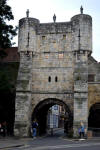 |
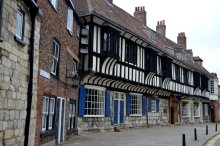 |
 |
 |
RIGHT: Bootham Bar and the Minster precincts |
And so it was time for the main attraction. I made a complete circuit of the exterior of York Minster before paying my £10 visitor fee to go inside. The timing turned out to be perfect as a light drizzle had started just minutes earlier. The interior of the building, one of the largest Gothic cathedrals in the world, was as magnificent as ever - but it was also quieter than I had ever previously seen. I spent over an hour just wandering around and taking it all in: the soaring architecture, a living masterpiece in stone and glass; the Nave and the sumptuously carved Choir; the High Altar and numerous side chapels; temporary exhibitions relating to restoration work; the astronomical clock; the Chapter House and the Undercroft; and more besides. A particular favourite was the breathtaking Kings Screen, which separated the Nave and Choir and provided numerous photographic opportunities. (The Minster authorities have no problem, incidentally, with non-commercial photography.)
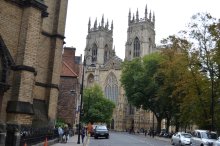 |
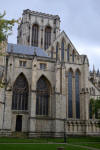 |
 |
 |
 |
|
 |
 |
 |
 |
 |
 |
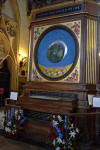 |
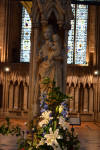 |
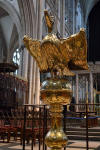 |
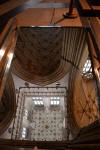 |
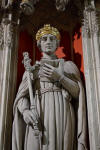 |
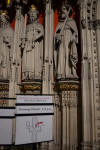 |
The timing of my visit turned out to be perfect for a second reason: it afforded me the privilege and pleasure of staying for Choral Evensong. Often regarded as the most quintessentially Anglican form of Christian worship, Evensong was created from elements of the traditional Catholic monastic offices of Vespers (evening prayer) and Compline (night prayer). The Church of England continues to earn much respect for its wonderful choral tradition and it is still the norm in many larger churches for Evensong to be offered with substantial parts of the service set to music and performed by a trained choir of the highest quality. A sizeable congregation had assembled and with ten minutes to go until the scheduled starting time, I took a seat in the choir stalls, directly behind the places allocated to the choir members themselves. With an admirable sense of dramatic build-up, the service began with singing in another part of the cathedral, audible but invisible to those waiting inside the enclosed area known as the Choir. The intensity of the sound increased until the procession entered the Choir and the people rose to their feet. The choristers, immaculately turned out in their cassocks and surplices, bowed to the High Altar in pairs and filed into their places, followed by two priests who were also in simple choir dress.
Three consecutively numbered psalms were sung in the distinctive and agreeable musical style known as Anglican Chant. Two readings ensued, each followed by one of the two great 'set pieces' of the service: the Magnificat (sometimes called Mary's Song of Praise) and the Nunc Dimittis (also known as the Song of Simeon). On this occasion, both "Mag and Nunc" were choral settings of their original Latin forms. The main musical content now over, a number of prayers were said, an anthem was sung and the choristers left in a manner comparable to that of their arrival, the final notes being delivered in a distant part of the great building.
Making sure that I gave a contribution towards maintenance of the Minster's glorious musical tradition, I left the building and re-entered the everyday, secular world, my head still awash with the sounds in which I had luxuriated for the last three quarters of an hour. The drizzle had stopped, but daylight was fading as I strolled the narrow streets of the old city centre - streets with names like Minster Yard, Petergate, Stonegate, Grape Lane, Swinegate and Colliergate. Perhaps best known of all was the Shambles, centre of a former butchers' quarter, where many of the buildings had a crooked appearance, with upper floors that protruded over the street.
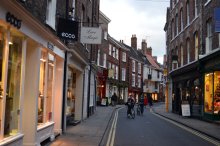 |
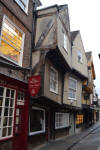 |
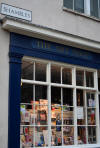 |
LEFT: Daylight begins to fade as I stroll through York's narrow city-centre streets |
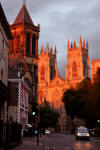 |
| RIGHT: But the Minster's western facade looks to be ablaze with the setting sun |
As I made my way back towards Lendal Bridge, an unexpected and striking visual effect was brought about by the setting sun. Despite thick cloud cover directly overhead, a clearance had opened up in the western sky allowing the sun, in the last few minutes before it slipped below the horizon, to light up the west front of York Minster with a strong, reddish glow. It was a magical moment, and I wasn't the only person who had noticed: drivers and cyclists alike pulled over to the side of the road to capture the scene on their smartphones.
I stopped at a pizza restaurant before returning to base, where I was able to relax and catch up with the day's news, content in the knowledge that the trip had got off to a great start.